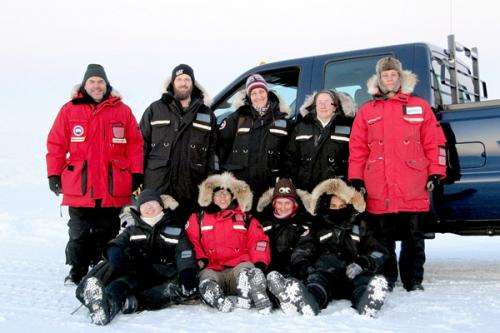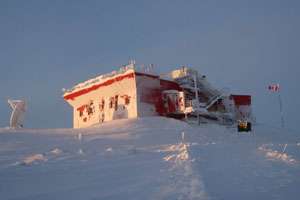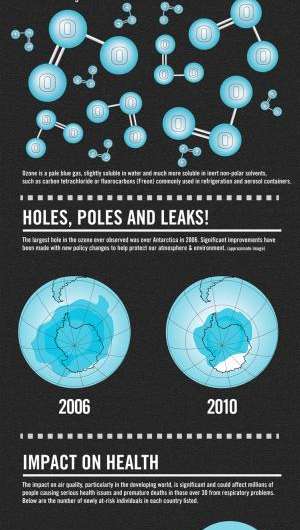U of T atmospheric physicist discusses ozone, climate change and the Quadrennial Ozone Symposium

As leading international scientists gather in Toronto to discuss new findings on ozone and climate change for the 22nd Quadrennial Ozone Symposium, U of T News spoke with Professor Kimberly Strong about her research, the Arctic ozone hole and atmospheric research at U of T.
Tell us a bit about your research – why is it so important to take ground-based, balloon-borne and satellite measurements of the atmosphere?
Measurements are vital to understanding what is happening in the atmosphere. Satellite measurements provide us with a global picture of our atmosphere, but ground-based measurements are also important. They provide long time-series, fill gaps in the satellite data record and play an important role in validating and assessing the quality of satellite measurements.
My research involves remote sounding of the atmosphere using ground-based, balloon-borne, and satellite instruments, for studies of stratospheric ozone chemistry, climate and air quality. We use a variety of spectroscopic techniques to measure the chemical composition of the atmosphere, combining these measurements with other datasets and computer models to improve our understanding of atmospheric processes and long-term changes.
One focus of our research is stratospheric ozone chemistry and the recovery of the ozone layer due to the phasing out of ozone-destroying chemicals under the Montréal Protocol.
Although we have a good understanding of ozone science, the atmosphere can still surprise us. The Arctic stratosphere, in particular, is highly variable from year to year, and in 2011, unprecedented chemical ozone depletion was observed in the Arctic. Ongoing space- and ground-based measurements continue to be essential to monitor the changing state of the ozone layer and the chemicals that control the ozone budget, especially in the polar regions. We need to unravel the links between ozone depletion and climate change in the years ahead.
Where do you conduct your field research?
We make ground-based measurements here on campus, at the University of Toronto Atmospheric Observatory (TAO) and in the Arctic, at the Polar Environment Atmospheric Research Laboratory (PEARL) at Eureka on Ellesmere Island. We are also involved in two Canadian satellite missions, both supported by the Canadian Space Agency, which are being used to study the ozone layer: the Atmospheric Chemistry Experiment (ACE; for which U of T physics professor Kaley Walker is deputy mission scientist) and OSIRIS on the Odin satellite.

You're the director of the training program at PEARL – how is this Polar Environment Atmospheric Research Laboratory important for students?
I am the director of the Natural Sciences and Engineering Research Council of Canada Collaborative Research and Training Experience Program (NSERC CREATE) training program in Arctic atmospheric science.
Our program takes advantage of the unique capabilities of PEARL (pictured right, photo by Dan Weaver), and aims to provide students and postdoctoral fellows with training in Arctic atmospheric science, including the use of state-of-the-art instrumentation and analysis of large data sets. The students supported under this program benefit from the significant investment that Canada has made in PEARL; they have access to a world-class facility, unique data sets and a large team of researchers with a breadth of expertise.
The goal of the training program is to significantly enhance the educational opportunities available to young researchers interested in polar, atmospheric, and climate sciences, enabling them to build collaborations and networks, and to develop scientific, technical, communications, and organizational skills. The training program includes formal and informal supervision, an exchange program, an annual summer school, research symposia, an undergraduate summer internship program and an industrial partnership program.
Why does U of T have an atmospheric observatory?
TAO was established in 2001 and we have been making regular measurements there since May 2002. The primary instrument at TAO is an infrared spectrometer that is a part of an international network called the Network for Detection of Atmospheric Composition Change (NDACC). We follow measurement and analysis protocols defined by the network and submit our composition measurements to the publicly available NDACC database. These data are used by us and others for a variety of studies, such as the detection of changes and trends in atmospheric composition and understanding their impact on the stratosphere and troposphere, validation of atmospheric measurements from satellites and testing and improving theoretical models of the atmosphere.
How important are international or multi-national collaborations in this area?
Atmospheric science tends to be highly collaborative, bringing together scientists with expertise in physics, chemistry, measurement techniques, laboratory studies and modelling. Such collaborations are crucial to advances in our field.

Can you tell us a bit about the international ozone conference taking place in Toronto this week?
The Quadrennial Ozone Symposium (QOS2012) is the flagship meeting of the International Ozone Commission (IO3C) and it has been held approximately every four years since the IO3C was established in 1948.
The theme for this congress is Ozone in our Changing Atmosphere. Given the renewed interest in ozone in light of last year's first-ever Arctic ozone hole, the meeting will bring together scientists from Canada, the United States and around the world. The Arctic ozone hole, which has similarities with the ozone hole over Antarctica, has given a new sense of urgency to international research and demonstrates the potential for climate change to compromise the recovery of the ozone layer. Measurements made at PEARL by PhD students Cristen Adams and Rodica Lindenmaier contributed to this discovery.
Canada is a world leader in ozone science, with over two decades of study of the Arctic atmosphere and a research program that began in the 1930s. Notable Canadian achievements include the development of the world's most accurate ozone-measuring instrument (the Brewer spectrophotometer, named after former U of T physics professor Alan Brewer) and the creation of the UV Index by Environment Canada.
The Montréal Protocol, the international agreement to protect the ozone layer, was also signed in Canada, on September 16, 1987. Under this agreement, concerted international action has been taken to reduce the emission of industrial chemicals that continue to threaten the ozone layer—the natural layer of gases in the upper atmosphere that protects life on Earth from the damaging UV rays of the sun.
Provided by University of Toronto



















